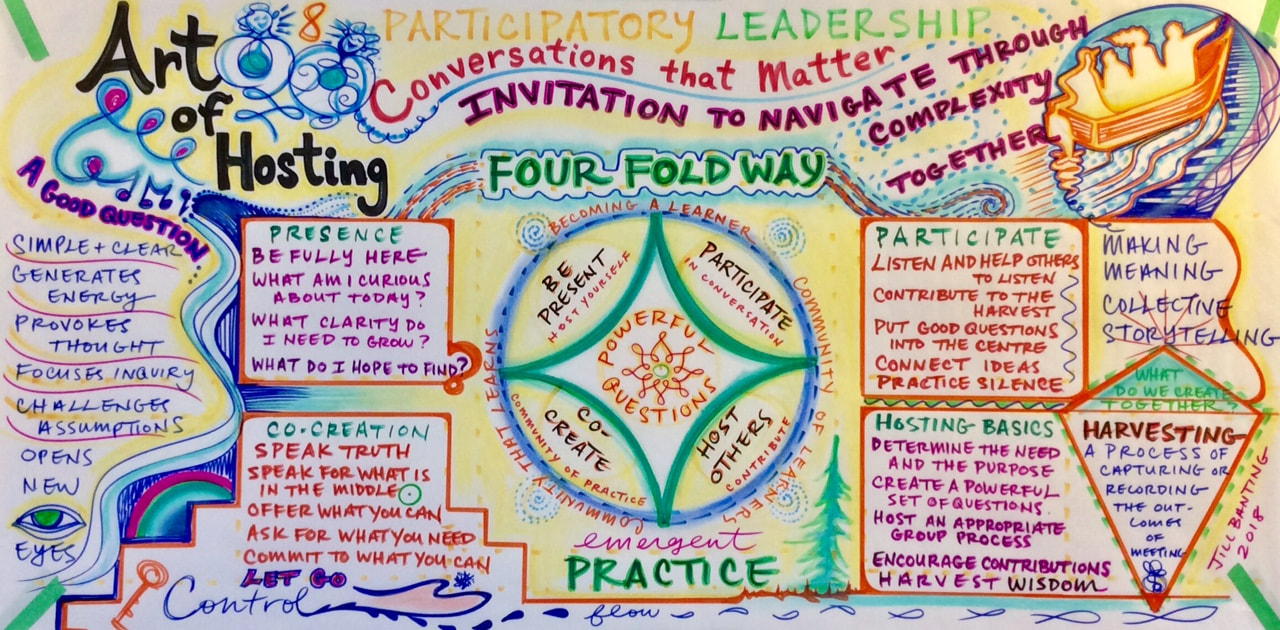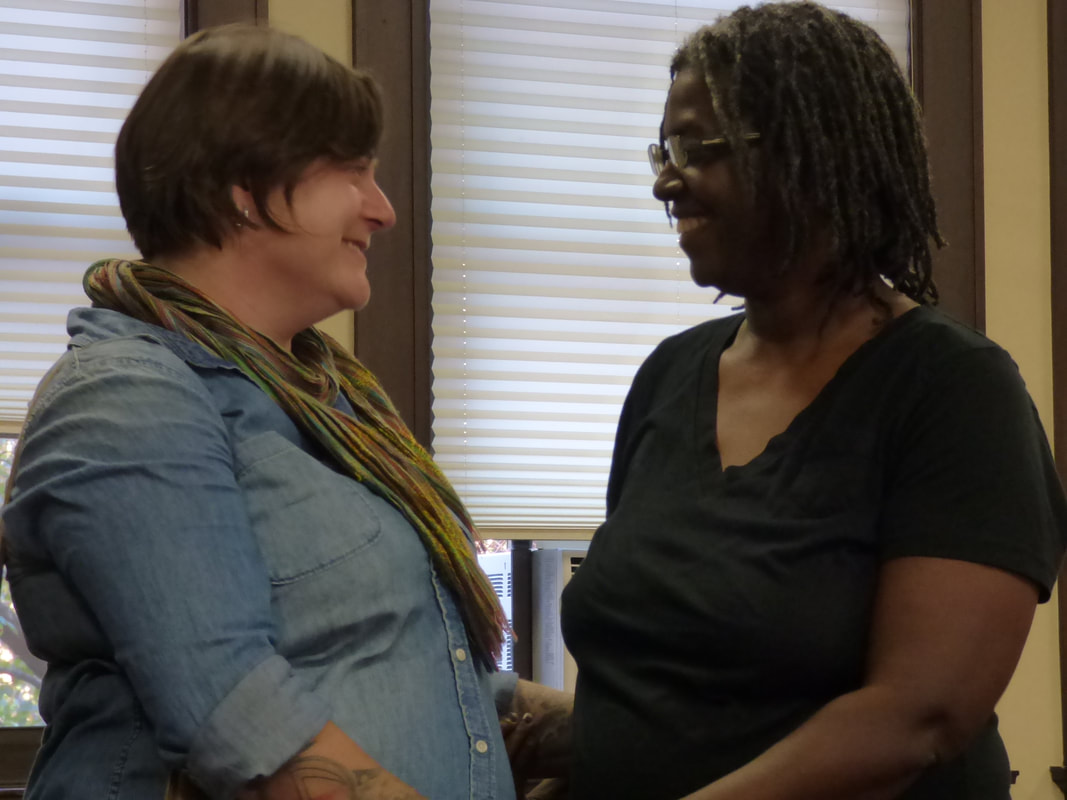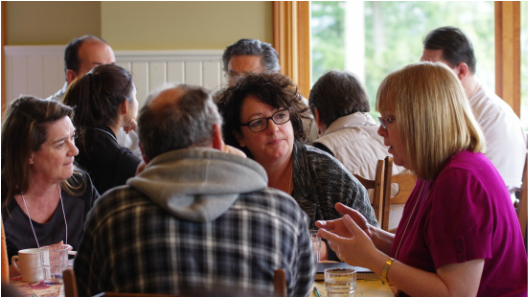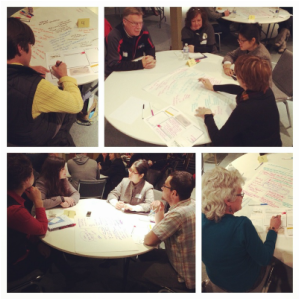A testimonial by Jill Alison
In the Fall of 2019, the Campbell River Arts Council was forming a proposal to work in collaboration with a network of organisations to address homelessness in the downtown core. As a community-engaged artist and visual facilitator, I was invited into the process. We were developing a systems change project, using an arts-based approach to create dialogue and engagement with street involved people, as well as their allies and other service providers, who were working to alleviate suffering in the affected communities.
The Art of Hosting was proposed as a way of working together, by introducing a set of systems change tools that would interrupt the current power structure representative of the typical meeting style. The goal was to move towards a more inclusive and equitable process of engagement, by bringing the voices of marginalized people into the centre and allowing a process of creative facilitation, dialogue, and participation to bring forward emergent solutions.
I was invited to attend the three-day, Art of Hosting training on Bowen Island with the intention of learning more about the practice. I felt at home in the space, nestled in a retreat-like atmosphere, with nourishing food and welcoming people. On the first evening, there was an opening circle where everyone introduced themselves and spoke briefly about why they were there. As the circle went around, Chris was quietly gathering snippets of people’s voices and composing a poem. When he read the poem out loud, a sense of wonder filled the room. His creative act was a kind of threshold, inviting an energy of unity and playfulness into the group. The experience showed me that creativity is a powerful way of opening space!
During the training, I met like minded people from all fields of practice and parts of the world. I felt seen and heard by others, and allowed myself to confront some of the blocks that were holding me back. I showed my vulnerability and stepped out of my comfort zone, using my voice in new ways. I sat in playful circles with fun-loving people and tense circles with spirited people having difficult conversations. I was blessed by people who were willing to listen and witness, coming away from the whole experience feeling more integrated and whole.
The Art of Hosting makes sense to me on a deep level and I felt both grounded and affirmed by the experience. As a visual scribe who practices deep listening, I value even the smallest voice in the room and intuitively sense that the group holds space together, forming an invisible field of presence. The training showed me that there is a skill in sensing both the seen and unseen energies in the room. To witness the team of highly skilled facilitators (Caitlin, Teresa, Amanda and Chris) work together in such a cohesive way was inspiring. They showed me how important it is to have both supportive colleagues and a community of practice that you know and trust. I came away feeling that my values can be aligned with a set of working principles, integrated into a creative process that is actionable and effective.
Thank you for this valuable training! I would highly recommend it to anyone who wants to work with people in authentic and collaborative ways.
The Art of Hosting was proposed as a way of working together, by introducing a set of systems change tools that would interrupt the current power structure representative of the typical meeting style. The goal was to move towards a more inclusive and equitable process of engagement, by bringing the voices of marginalized people into the centre and allowing a process of creative facilitation, dialogue, and participation to bring forward emergent solutions.
I was invited to attend the three-day, Art of Hosting training on Bowen Island with the intention of learning more about the practice. I felt at home in the space, nestled in a retreat-like atmosphere, with nourishing food and welcoming people. On the first evening, there was an opening circle where everyone introduced themselves and spoke briefly about why they were there. As the circle went around, Chris was quietly gathering snippets of people’s voices and composing a poem. When he read the poem out loud, a sense of wonder filled the room. His creative act was a kind of threshold, inviting an energy of unity and playfulness into the group. The experience showed me that creativity is a powerful way of opening space!
During the training, I met like minded people from all fields of practice and parts of the world. I felt seen and heard by others, and allowed myself to confront some of the blocks that were holding me back. I showed my vulnerability and stepped out of my comfort zone, using my voice in new ways. I sat in playful circles with fun-loving people and tense circles with spirited people having difficult conversations. I was blessed by people who were willing to listen and witness, coming away from the whole experience feeling more integrated and whole.
The Art of Hosting makes sense to me on a deep level and I felt both grounded and affirmed by the experience. As a visual scribe who practices deep listening, I value even the smallest voice in the room and intuitively sense that the group holds space together, forming an invisible field of presence. The training showed me that there is a skill in sensing both the seen and unseen energies in the room. To witness the team of highly skilled facilitators (Caitlin, Teresa, Amanda and Chris) work together in such a cohesive way was inspiring. They showed me how important it is to have both supportive colleagues and a community of practice that you know and trust. I came away feeling that my values can be aligned with a set of working principles, integrated into a creative process that is actionable and effective.
Thank you for this valuable training! I would highly recommend it to anyone who wants to work with people in authentic and collaborative ways.




 RSS Feed
RSS Feed
